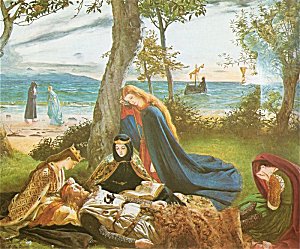 |
The Mabinogionby Lady Charlotte Guest[1877] |
 |
The Mabinogionby Lady Charlotte Guest[1877] |
This is Lady Guests' translation of the Mabinogion. The Mabinogion is a cycle of Welsh legends collected in the Red Book of Hergest, a manuscript which is in the library of Oxford University. Mabinogion means 'tales of youth'; although this appellation only applies to a few of the stories, Lady Guest appropriated it as the title of this book, and The Mabinogion is now used as the name of the entire collection. The stories are based on historical characters and incidents from the dark ages in Wales and environs, embellished with supernatural and folklore elements. Throughout there are echoes of primordial Celtic mythology and folklore, including the ancient gods and goddesses.
The first five tales are Welsh versions of incidents from the Arthurian canon. The Mabinogion per se consists of the four connected narratives (called 'the branches') from Pwll, Prince of Dyved, through Math, the Son of Mathonwy. Following these are three additional stories, including the legend of one of the most famous bards of Wales, Taliesin.
The Mabinogion is one of the masterpieces of world literature, and a must-read for anyone who wants to have an understanding of Celtic lore.
One minor barrier for some readers may be the spelling of Welsh, particularly in place names and names of people. In a nutshell, 'w' and 'y' are vowels, pronounced like 'u' and 'i' respectively. Technically, double 'l' is voiceless; rest assured, 'Ll' at the start of a word is not a typo. So 'Pwyll', which on the face of it doesn't appear to have any vowels, can be thought of as being pronounced approximately like 'poo-eel'.
PRODUCTION NOTES: This version is up to current site standards, and includes anchored page numbers, linked foot- and end-notes, and so on. This version includes all of the endnotes which are omitted from previous etexts of this book, and corrects several errors in the body text. Unicode is used through this text to display archaic orthography.
John Bruno Hare, March 4th, 2004.